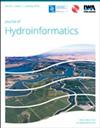饮水管网中自主机器人的最佳充电站布局
IF 2.2
3区 工程技术
Q3 COMPUTER SCIENCE, INTERDISCIPLINARY APPLICATIONS
引用次数: 0
摘要
饮用水公司和商业供应商正在开发电池供电的自主机器人,用于管道的内部检查。然而,这些机器人需要附近的充电站靠近供水网络(WDN)的管道。这就引发了有关充电站和机器人最少数量的实际问题。为了解决这些问题,基于充电站沿管道到每个节点的最短路径,制定了一个整数线性规划优化,类似于集覆盖。优化决策围绕着将节点指定为充电站,考虑机器人可以覆盖硬约束的最大距离(δmax)。对于最优安置,提出了两个目标公式:(i)尽量减少站的总数,代表总成本;(ii)最大化系统的总冗余。该方法应用于三种WDN拓扑结构(即摩德纳、五水库和E - Town)。结果表明,拓扑结构对充电站网络的总充电站数量、机器人数量和冗余度的影响。δmax和总台数之间的权衡强调了机器人电池容量的重要性。本文章由计算机程序翻译,如有差异,请以英文原文为准。
Optimal charging station placement for autonomous robots in drinking water networks
Drinking water utilities and commercial vendors are developing battery-powered autonomous robots for the internal inspection of pipelines. However, these robots require nearby charging stations next to the pipelines of the water distribution networks (WDN). This prompts practical questions about the minimal number of charging stations and robots required. To address the questions, an integer linear programming optimization is formulated, akin to set covering, based on the shortest path of the charging stations to each node along a pipeline. The optimization decisions revolve around designating nodes as charging stations, considering the maximum distance (δmax) at which a robot can cover a hard constraint. For optimal placement, two objective formulations are proposed: (i) minimize the total number of stations, representing total cost; and (ii) maximize the total redundancy of the system. The methodology is applied to three WDN topologies (i.e. Modena, Five Reservoirs, and E−Town). Results show the influence of topology on the total number of stations, the number of robots, and the redundancy of the charging stations network. A trade-off between δmax and total number of stations emphasizes robot battery capacity's significance mariocastrogama.
求助全文
通过发布文献求助,成功后即可免费获取论文全文。
去求助
来源期刊

Journal of Hydroinformatics
工程技术-工程:土木
CiteScore
4.80
自引率
3.70%
发文量
59
审稿时长
3 months
期刊介绍:
Journal of Hydroinformatics is a peer-reviewed journal devoted to the application of information technology in the widest sense to problems of the aquatic environment. It promotes Hydroinformatics as a cross-disciplinary field of study, combining technological, human-sociological and more general environmental interests, including an ethical perspective.
 求助内容:
求助内容: 应助结果提醒方式:
应助结果提醒方式:


